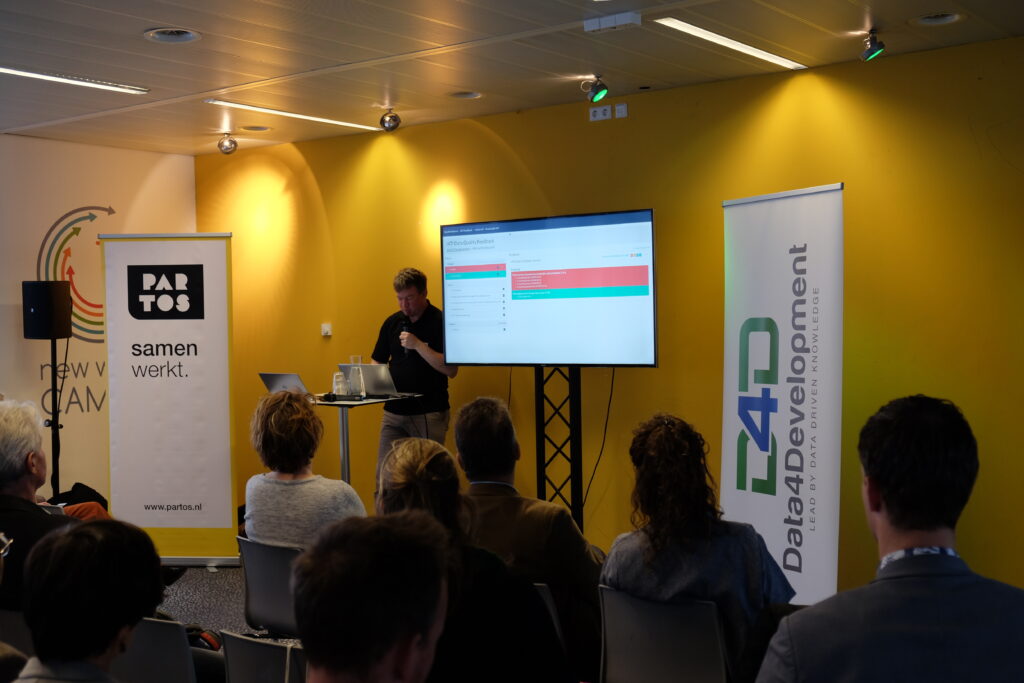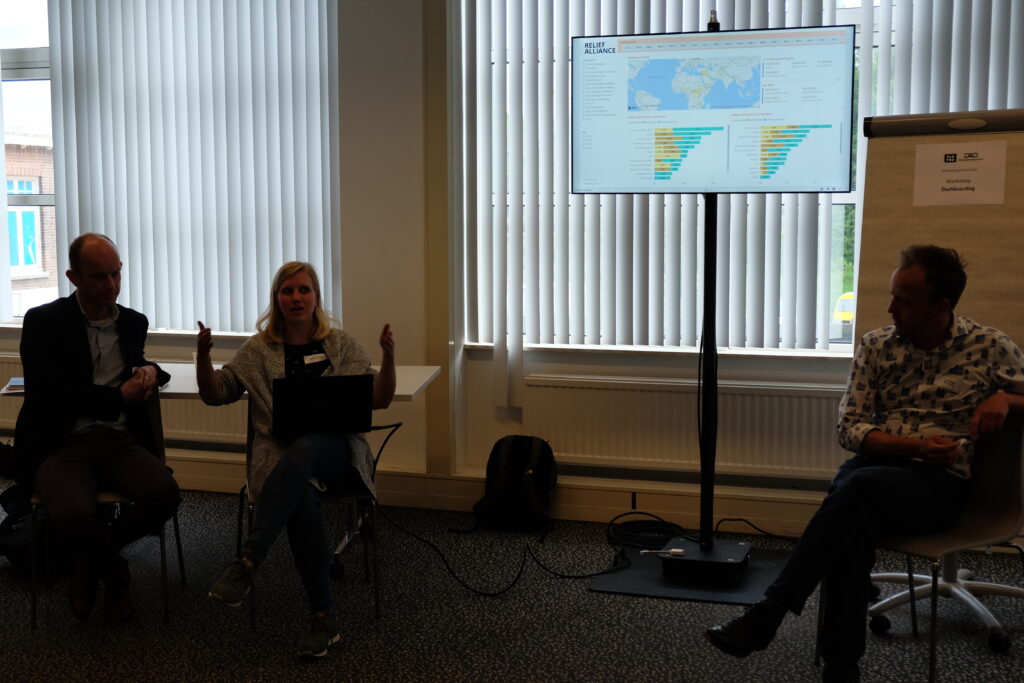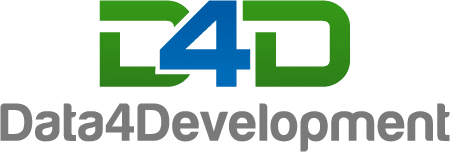Reporting Back on the IATI Learning Event 2019
IATI: From Publication to Data Use
We were happy to welcome around 70 national and international participants during the 4th Partos IATI Learning Event, organized by Partos and Data4Development, and financially made possible by The Spindle, Partos Innovation Platform.
This year, data use was central to the presentations and discussions. We are seeing a growing interest amongst Dutch civil society in unpacking the IATI black box and in seeking opportunities to use IATI data. New opportunities but also challenges are emerging in the field of results reporting, data quality, dashboarding and data security.
IATI in 2019 – Where do we stand?
At the start of the event, before diving into the reflections and details, we wanted to get a taste of where the participants stand in their IATI journey. It was time to vote and participate in order to find out where we stand!
To get a feeling of the participants’ general associations with IATI, we wanted to know the first word that popped into their mind when thinking of IATI. This resulted in an interesting mind map, with usual suspects such as data, transparency and accountability but also some surprises.

When we asked the participants what the organization’s key motives is for publishing in IATI, the answer was overwhelmingly similar: Around two-third of the participant’s primary motive is ‘meeting external donor requirements’. But we could also see that a number of organizations publish IATI data for different motives, such as coordinating amongst partnerships, meeting internal requirements and monitoring. A common pattern was identified by the audience that organizations often start to publish in IATI motivated by meeting external requirements, but that as experience is growing, other purposes and motives are growing increasingly important.
Lastly, we asked the participants to map the level of maturity of the organizations they work for, in terms of IATI awareness, IATI publication and the use of IATI Data. We see that the Dutch civil society considers itself to be IATI aware and a fair practitioner in the field of publishing in IATI. While we see increasing curiosity, confidence in using IATI data is still lacking behind considerably.
IATI Context & Trends
Reporting back from the IATI Technical Advisory Group (Leo Stolk, Rolf Kleef)
Interestingly, during the annual meeting of the IATI Technical Advisory Group (TAG) in November 2018, the primary focus was also on using IATI data.
The TAG meeting discussed the developments around the Data Use Strategy 2017-19. This strategy consists of five themes to promote the use of IATI data: Awareness Raising, Data Quality, Tools, Guidance and Aid Information Management System (AIMS) Integration. All relevant developments on the Data Use Strategy and more can be read in the IATI TAG 2018 Report.

At the meeting, special attention was given to the use of IATI data in humanitarian contexts. Currently, a pilot has been launched to integrate IATI data into the UN’s Office For Coordination of Humanitarian Affairs (UN OCHA) Financial Tracking Service (FTS).
From reflections on the current state of IATI, the TAG looked forward to the next strategic period and pointed out a first collection of key directions for the future.
In terms of technical updates, we see new features come and old features go. The TAG agreed that the IATI Standard version 1 will be deprecated by the end of June 2019. If your organization still uses version 1, you are urged to convert your current IATI dataset to version 2. In addition, a new IATI data store and an IATI validation tool is being built. Zooming in to the IATI Standard itself, we see new terminology for the activity status list and new additions to the policy markers.
Humanitarian Guidelines by the Dutch Ministry of Foreign Affairs (Pelle Aardema)
The potential for and importance of using IATI data in humanitarian contexts is increasingly recognized. The commitment to transparency was laid down in the Grand Bargain as part of the World Humanitarian Summit in 2015 and includes changes to the IATI Standard in order to make the standard the best fit for humanitarian contexts. In order to put the possibilities of the standard to practice, the Dutch Ministry of Foreign Affairs developed a set of humanitarian guidelines (in addition to the NL IATI publication deadlines) for how to best use the IATI Standard to publish data about activities in humanitarian contexts. The guidelines have been developed in close consultation with UN OCHA, DFID and Development Initiatives in order to create a common understanding of the IATI Standard and its elements in relation to humanitarian activities. The guidelines are now open for consultation of Dutch partners and can be accessed here and discussed in the supporting IATI discussion forum.
Using IATI Data: 3 Perspectives
Using IATI Data: Results Reporting (Herman van Loon & Anna Linders)
What do the Tower of Babel and IATI have in common? The importance of speaking the same language. As the world is growing increasingly complex, just like the humanitarian and the development sector, and while ambitions to create impact do not halt – having one central language is essential to communicate and coordinate in order to succeed.
This ambition was central to the Dialogue & Dissent Strategic Partnership: To use the IATI Standard beyond the traditional focus on transparency and compliance, but to use the IATI data to communicate in an alliance with 25 Strategic Partnerships and even more partners. With efforts of both the Dutch Ministry of Foreign Affairs as well as all partners, these efforts resulted in an interactive dashboard based on IATI data and an annual report. The annual report for 2018 has just been launched and can be accessed here.
But as learning a language requires time and patience, so does the road to being able to communicate in a common language. This has proven challenging as the Ministry used a bottom-up approach to develop a common results framework. This left a substantial amount of flexibility to partners, but made telling one story, in one language challenging.
In order to enhance this common story, the Dutch Ministry of Foreign Affairs has recently launched new guidance for interpreting the Dialogue & Dissent results framework. A key lesson here is the importance of a qualitative interpretation to the quantitative results. While they face challenges, the Ministry is committed to continue the journey towards a common language using the IATI Standard, using Star Trek’s famous phrase: Let us continue to boldly go where no man has gone before.
Using IATI Data: Ensuring Quality with the IATI Quality Validator (Rolf Kleef)
It is not only about data input anymore. As we are slowly unpacking the IATI black box, we discover that the quality of our IATI data is of crucial importance to what extent and how we can use our data. However, determining the level of quality of IATI data is subject to different layers and different users.
The first layer is the technical layer, looking at the data from a developer’s perspective: Is it a valid XML? Does it comply with the schema? However, while IATI data should be technically valid, in order to make the data meaningful, we come to the IATI Standard layer. This can be considered as the rules, requirements and guidelines as developed by the IATI Standard itself. Zooming in further, we see that different donors have developed different guidelines in order to meaningfully aggregate, interpret and communicate IATI data to a high-over level. Last but certainly not the least, your own organizations might have their own organization’s rules or requirements in order to use the IATI data and make it speak.
In order to test and verify IATI data to all requirements for all different users, Data4Development has developed the IATI Data Quality Feedback Tool with support of the Dutch Ministry of Foreign Affairs and DFID. You can not only test your IATI dataset against the IATI Standard, but also against the Dutch and UK guidelines. Are you ready to improve your dataset in order to better use your IATI data? Test your own data at www.dataworkbench.io.
Using IATI Data: Making data speak through dashboarding
When working together with 16 organizations in different humanitarian settings, how to best use IATI data to monitor and to coordinate? As a response to this question, the Dutch Relief Alliance (DRA) chose to develop a dashboard based on IATI data as a central mean to monitor all activities of different organizations in one humanitarian context (Joint Response) and to report collectively to the Dutch Ministry of Foreign Affairs (being the donor). The current dashboard has been developed in collaboration with Data4Development and allows the alliance to do cross-sectional analysis of their IATI data per Joint Response, per organization and per year.

However, those who think a dashboard is a standardized product are incorrect – the development has been and still is an ongoing process of puzzling, coordination, joint agreements and technical fixes. Because while the IATI Standard is one model, it provides a level of flexibility to structure and interpret data in different ways. To link and align data in order to meaningfully aggregate quality data to the Joint Response or overall level has proven to be a main challenge. Coordination and joint agreements are required to find a balance between the mandate of the DRA as well as mandates and systems of the individual organizations and necessary manual technical fixes. The goal has not been reached yet – The DRA and Data4Development will continue the ongoing process of refining the dashboard (both in terms of technicalities as well as quality data) is order to make the dashboard more and more meaningful.
Workshops: Reporting Back
Dashboarding
A common challenge identified in the Dashboarding sessions is finding room for and visualizing qualitative data. Only with quantitative and qualitative data can we understand the whole story. As qualitative data is especially important to providing context to quantitative data or motivation to decision making processes, we should focus as a community to being able to take this up into a dashboard, allowing us to narrate the full story.
Besides recognizing this challenge, participants did see an opportunity in visualizing data through dashboarding as it allows you to look at the data. The quality of data only improves when we look at,discuss and engage with the IATI data. Here again, it was emphasized that dashboarding is a process that takes time and patience. However, as you continue to give it attention, you will see the quality continues to improve.
Data Safety
In the Data Safety session, the participants put their minds together to develop a step-by-step plan to ensure data safety is well embedded in your organization and your IATI publications:
Step 1: Draw up a data policy
Identify potential risks (e.g. legal, personal, organizational) of the data that you publish in IATI; draft an exclusion policy.
Step 2: Align your policy and actions with the General Data Protection Regulation (GDPR)
Make sure that at all times, also in your IATI publications, GDPR is adhered to.
Step 3: Think before you start a new project and think ahead
Before you decide to start any project: make sure to consider what data can and what can’t be published – do this with your partners! Take national laws into consideration. Think three years ahead, take into account what could happen in the context of your activities.
Step 4. Publish Data Sensibly
Put your policy into practice: always take the responsibility to check your data when you are about to publish. But also be sensible to the objective of IATI and transparency: Find solutions in being as transparent as possible (e.g. anonymizing), without putting safety at risk.
Data Quality
In the Data Quality sessions, a common challenge identified to ensuring the quality of IATI data is the focus of publishers towards upwards accountability. As outlined in the plenary session on data quality, upward accountability and donor guidelines are one layer to determining the quality of IATI data, but is equally important to the other layers. Prioritizing the donor guidelines over internal guidelines, might prevent organizations to see the real value and quality of their IATI data.
Instead, data quality should be internalized as a shared responsibility – amongst both organizations as well as the ones who input the data. Using IATI data in your organization provides an opportunity for data quality: The consequences of incomplete data or data of low quality becomes increasingly relevant when organizations start to interact with their IATI data. Here, it can also help to perceive your IATI data as a story to the outside world: What do you want to tell the wider audience?
Results Reporting
In the Results Reporting sessions, central to the discussions was where IATI is for and where IATI is not for in relation to results reporting. IATI is seen and used as a tool to aggregate results on program or higher level, but is this possible by solely automation, without human interpretation? A common challenge identified here is grasping the nuance and to contextualize the diversity of results on an aggregated level. While IATI should create space for qualitative interpretation of quantitative results, it was questioned if IATI should be the mean to capture and report qualitative results.
Going back to the core of the purpose of IATI, provides an opportunity to contextualize and shape your results reporting. In the end, IATI is not about the results achieved of one organization, IATI is about coordinating activities and stimulating accountability towards the context and it’s population. Keeping this in mind helps organizations to design the results reporting for IATI in a more practical way, rather than focused on an organization’s own story or results.
What’s next?
As we are well over half of the program period of the Dutch Ministry of Foreign Affairs’ Strategic Partnerships, it is time to inventorize where we stand in terms of IATI.
As such, we have shared a short survey to share your organization’s experience with IATI in the context of the Strategic Partnership programming.
You can find the survey here. (open till 14th of June, 2019)
Peer learning
One of the suggestions that Partos received after the meeting was to organize small size peer learning sessions where organisations can share their experiences and challenges with the publication to IATI on the basis of the MFA Guidelines for Dialogue and Dissent. Interested? Contact Partos.
Data Visualisations
Another idea that came up in the after talks was to organize next year a data hackathon with a call for interesting visualisations of the data then available in IATI on the Dialogue & Dissent Program. Any thoughts about this? Contact Anne-Marie Heemskerk at Partos ([email protected])
Training
Data4Development invites you to the new IATI Publishing Starter Training! Practical and specifically adjusted to your IATI knowledge level and learning needs.
What? International Aid Transparency Initiative (IATI) starter training
- Understand what you can use IATI for;
- Put the main concepts of an IATI publication in practice;
- Develop a structure of your publishing activities for your IATI publication
When? July 3rd and September 11th, 2019
Do you want to register? Sign up here!
More information? See our website or send an email to [email protected].

